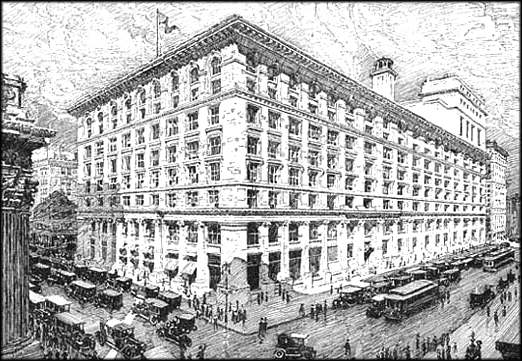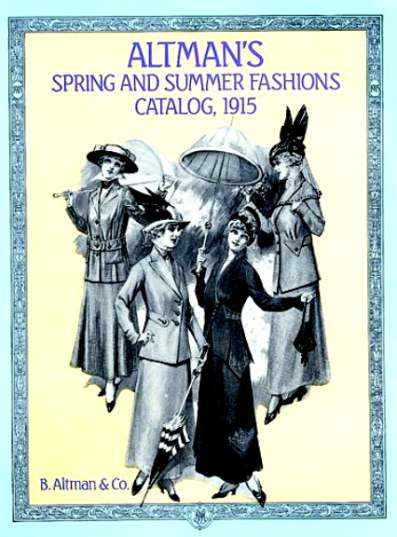Beautifully engraved Bond certificate from the B. Altman & Co. issued no later than 1920. This historic document was printed by the American Banknote Company and has an ornate border around it with the company's name on top. This item is handsigned by the Company's President ( Colonel Michael Friedsam ) and Secretary ( Charles Hayman ). 
B. Altman & Co. Building 
Cover of the B. Altman & Co. 1915 Catalog Benjamin Altman was born in New York, 1840 and died there in 1913. He was the son of Bavarian Jews, who emigrated to America in 1835 and opened a small store on Attorney St. Benjamin Altman started for himself in 1865 on Third Ave., New York, later acquiring his brother Morris' business on Sixth Ave. In the latter store Benjamin remained for 30 years, for it was not till 1906 that he moved to Fifth Ave. and 34th St., and with Michael Friedsam formed the firm of B. Altman & Co. Shortly before his death, he established the Altman Foundation, of which $20,000,000 represented by his art collection, was given to the Metropolitan Museum, New York. Col. Michael Friedsam was born in New York City on February 10, 1860. He attended the New York Public Schools and Weston Military Academy in Weston, CT. In 1913, Col. Friedsam became president of the B. Altman Co., a position that he kept until his death. Col. Friedsam was reported to be a humanitarian and to be very influential in the civic affairs of the City. During World War I, he served as Quartermaster General of the New York State Guard, from which he retired with the rank of colonel. Friedsam died on April 6, 1931 (Dedication Booklet). Besides a few other financial matters, he had the majority of his fortune set aside to form a foundation that donated money to institutions that promoted the betterment of youth and the human condition. St. Bonaventure was deemed to be such an institution. The Friedsam Memorial Library is often considered to be the most beautiful building on campus. Built in 1938, it replaced the library in Alumni Hall after its fifty years in service. Construction of their new location began in 1905, and B. Altman & Co. opened their new store in 1906. The Madison Avenue end wasn't added until 1914. Benjamin Altman died in 1914 and never saw the completion of his entire city-block store. It was the first large-scale department store on Fifth Avenue. The building was designed to blend into the grand residential structures that dominated the area at that time. The architects were Trowbridge and Livingston, who also designed the St. Regis Hotel (1904), the J.P. Morgan headquarters on Wall Street (1913), and the Hayden Planetarium (1935). When originally built, a niche occupied by Knoedler art dealers was left in the southwest corner (Fifth Avenue and 34th Street). When Knoedler finally moved in 1910, the corner of the current structure was added. Went without outside signs for 25 years, perhaps out of deference to high-class residential neighbors. Was built catty-corner to the original Waldorf-Astoria Hotel. Now stands catty-corner to the Empire State Building. During World War I the company began displaying what may have been the largest American flag ever hung. It measured 100 by 65 feet and covered much of the building's Fifth Avenue front. Made during the Spanish-American War, it was last flown at the end of World War II. The American Olympic team depicted in the film Chariots of Fire trained on a rooftop running track. Escalators taken from 1939 World's Fair pavilions were incorporated into the structure. A miniature community, the store had a seven-bed medical department, staffed by a doctor and two nurses who provided medical care to employees and, on an emergency basis, to customers. There was also a school that offered lessons in the three R's to younger employees and a power plant in the subbasement. Its powerplant made the building an oasis of electricity during New York's 1965 blackout. People came there seeking refuge from the dark and heat, and Altman's only closed the doors when they felt they had all the "refugees" they could handle. The department store's staff passed around free sandwiches, and people slept in the furniture department, on the floors... wherever they could. The building received landmark status in 1985. The building closed in 1989 when B. Altman & Co. went out of business. The Oxford University Press moved into the Madison Avenue side of the building in 1995, and the New York Public Library's Science, Industry, and Business Library, also on the Madison Avenue side, arrived in 1996. In 1999, the building became the new home of the CUNY Graduate Center, which occupies about three-fifths of the building and fronts on Fifth Avenue. History from Altman and Friedsam foundation websites.

B. Altman & Co. Building

Cover of the B. Altman & Co. 1915 Catalog










